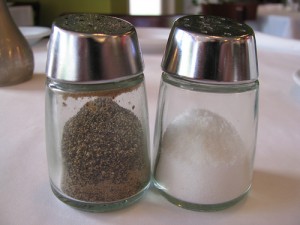 When we think of sodium and fast foods, many of us think of the burger joints like McDonalds and Burger King. Most people know that these foods are high in sodium, and that an increased intake of sodium over time can contribute to disease conditions like high blood pressure, osteoporosis, water retention and even increases your chances of stomach cancer.
When we think of sodium and fast foods, many of us think of the burger joints like McDonalds and Burger King. Most people know that these foods are high in sodium, and that an increased intake of sodium over time can contribute to disease conditions like high blood pressure, osteoporosis, water retention and even increases your chances of stomach cancer.
How Much Salt Is Too Much?
New guidelines are suggesting that we consume no more thatn 1500mg per day, it is estimated that the average Canadian is consuming double this amount.
Just to put this number into perspective 1 tsp of salt contains 2400mg of sodium. However most of the salt we are eating is not coming from the table salt we are using to salt our foods or adding to our cooking. While we still want to limit this, most of the salt is lurking in the processed, packaged and fast foods we are eating.
We know that things like frozen dinners and canned soups are high in sodium, but take a look the next time at processed meats, or canned tomato sauce or even certain breads. It can all add up.
Lurking Sodium
Lets take a look at some of the sodium that is lurking in the fast foods that you are eating…
- Tim Hortons 12 grain bagel – 590mg
- Tim Hortons Chicken Snack Wrapper – 610mg
- Starbucks Italian pesto, cheese and tomato sandwich – 900mg
- Tim Hortons Soups (individual) – average 900mg
- Kelseys veggie burger – 950mg
- Kelseys broccoli and cheddar soup – 1020mg
- Manchu wok green bean chicken with mixed veggies – 1070mg
- Tim Hortons Chicken Club Sandwich – 1070mg
- Mr greek, greek salad with dressing – 1160mg
- Boston pizza veggie pizza (individual) – 1160mg
- Swiss chalet chicken soup – 1380mg
- Starbucks egg and spinach and feta wrap – 1140mg
- Swiss chalet grilled chicken caeser salad with dressing – 1730mg
- Montanas roasted salmon with rice and veggies – 1780mg
- Swiss chalet ¼ chicken dinner with dipping sauce and rice – 2020mg
- Swiss chalet chicken stirfry with rice – 2290mg
- Montanas turkey club sandwich – 2320mg
- Kelseys nachos and cheese – 3530mg
As you can see, some of these choices are actually the best ones on the menu but they still have increased sodium. It is not really their fault, they have to get their produce in bulk and when they do that it has to be preserved so it wont spoil and salt is an easy way to prevent the spoilage. Also – we demand that foods tastes good, and our plates like salt. The more we eat, the more we want.
In Conclusion
While all of these foods are great and fine occasionally, if you are eating lunch out everyday it is important to re-evaluate these choices and start making this stuff at home. It use to be that eating out was a luxury or social, so it really didn’t matter if a couple times a month you were over your sodium intake. Now it seems that people are eating out 1-2x/day which as you can see can really add up and increase your risk factors for disease!